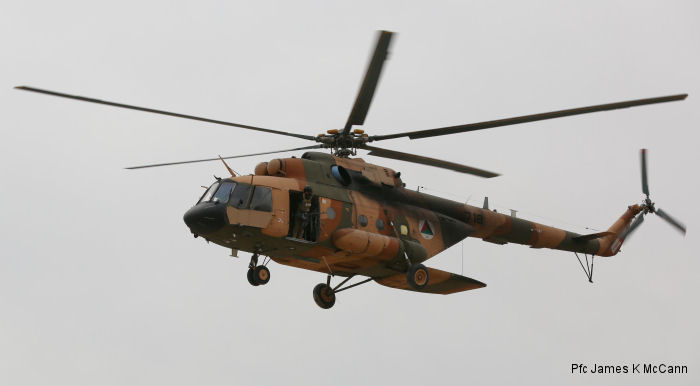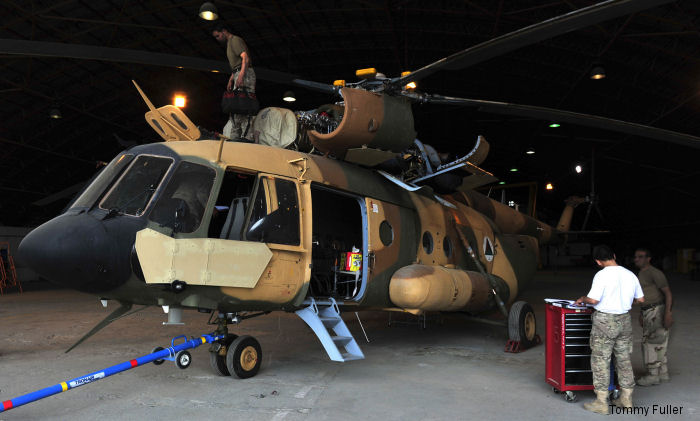US Air Force, August 12, 2015 - AFGHANISTAN by Tommy Fuller - Can specialized mechanical, electrical, and logistical skills be rolled into one person? Sure can, just ask the experts who maintain the fleet of military helicopters at the Afghan Special Mission Wing.
SMW is a unique aviation unit of the Afghan National Defense and Security Forces that partners with the Special Forces capabilities of the Ministry of Defense and Ministry of Interior. The MI-17s provide the ANDSF with the air-assault capability they need for night missions.
Maintaining complex aircraft, such as the Russian-made MI-17, requires highly trained experts and an innovative approach for developing aircraft maintenance teams capable of sustaining squadrons of helicopters.
Most maintenance for flight operations is now performed by contract technicians. As new Afghan aircraft mechanics complete their training and become more proficient, they are assigned to support the maintenance effort.
One initiative implemented by the U.S.-led train, advise and assist team has improved the work flow and could signal future success of an Afghan-led maintenance program.
Students are organized into teams of five or six that remain intact until they graduate from the program and then assigned to the field as a team - training and then working - together side by side.
Sometimes the Afghan culture of respecting others in positions of authority can impact maintenance procedures, but training technicians to work as a team, has overcome this obstacle.
“If one guy has all the knowledge in one area and is absent for some reason, other technicians working alongside will often wait on him to complete his part of the job before proceeding,” said a U.S. Army maintenance officer.
“If he’s gone for a month, the job doesn’t get done for a month. But, as a team, with technicians all working together for the long period of time in training, they become comfortable with each other and a lot more productive,” he said.
Another initiative will play a large role in sustaining the maintenance mission. For the first time an Afghan soldier is being trained to be an instructor - a specially qualified technician - who can float among the teams and provide on-the-job assistance.
Eventually, the SMW will bring in an officer who will lead the Afghan maintenance training.
“First we have an Afghan soldier doing spot checks. Then we are going to have Afghan soldiers as part of a team training additional people,” said a U.S. contract trainer. “This has been going on for a year-and-a-half and we are just now gaining the momentum to go over the top of the hill.”
It takes about 540 days before a fledgling maintenance technician becomes a really good mechanic. About a third of the time is spent in a classroom followed by many hours of on-the-job training, the tempo of which relies on the maintenance schedule of the Wing’s aircraft. It’s a reminder that this is not a school house, but a vibrant, operational unit.
“With the OJT, the problem is that it is opportunity based,” said the U.S. trainer. “It might be a month before we have a 300-hour inspection that requires technicians to do a certain task. That makes it difficult to predict how many OJT days it will take to complete the training, but it averages out to be about 540 days.”
On Aug. 1, the most recent six-man team completed training and another group started their training on Aug 8.
“We have graduated about 85 new maintainers since 2009, and we graduated about 50 of those this year,” said the U.S. Army maintenance officer. “And, we are ramping up to produce enough maintainers that, in three to five years, the Afghans can take over the whole operation.”
SMW is a unique aviation unit of the Afghan National Defense and Security Forces that partners with the Special Forces capabilities of the Ministry of Defense and Ministry of Interior. The MI-17s provide the ANDSF with the air-assault capability they need for night missions.
Maintaining complex aircraft, such as the Russian-made MI-17, requires highly trained experts and an innovative approach for developing aircraft maintenance teams capable of sustaining squadrons of helicopters.
Most maintenance for flight operations is now performed by contract technicians. As new Afghan aircraft mechanics complete their training and become more proficient, they are assigned to support the maintenance effort.
One initiative implemented by the U.S.-led train, advise and assist team has improved the work flow and could signal future success of an Afghan-led maintenance program.
Students are organized into teams of five or six that remain intact until they graduate from the program and then assigned to the field as a team - training and then working - together side by side.
Sometimes the Afghan culture of respecting others in positions of authority can impact maintenance procedures, but training technicians to work as a team, has overcome this obstacle.
“If one guy has all the knowledge in one area and is absent for some reason, other technicians working alongside will often wait on him to complete his part of the job before proceeding,” said a U.S. Army maintenance officer.
“If he’s gone for a month, the job doesn’t get done for a month. But, as a team, with technicians all working together for the long period of time in training, they become comfortable with each other and a lot more productive,” he said.
Another initiative will play a large role in sustaining the maintenance mission. For the first time an Afghan soldier is being trained to be an instructor - a specially qualified technician - who can float among the teams and provide on-the-job assistance.
Eventually, the SMW will bring in an officer who will lead the Afghan maintenance training.
“First we have an Afghan soldier doing spot checks. Then we are going to have Afghan soldiers as part of a team training additional people,” said a U.S. contract trainer. “This has been going on for a year-and-a-half and we are just now gaining the momentum to go over the top of the hill.”
It takes about 540 days before a fledgling maintenance technician becomes a really good mechanic. About a third of the time is spent in a classroom followed by many hours of on-the-job training, the tempo of which relies on the maintenance schedule of the Wing’s aircraft. It’s a reminder that this is not a school house, but a vibrant, operational unit.
“With the OJT, the problem is that it is opportunity based,” said the U.S. trainer. “It might be a month before we have a 300-hour inspection that requires technicians to do a certain task. That makes it difficult to predict how many OJT days it will take to complete the training, but it averages out to be about 540 days.”
On Aug. 1, the most recent six-man team completed training and another group started their training on Aug 8.
“We have graduated about 85 new maintainers since 2009, and we graduated about 50 of those this year,” said the U.S. Army maintenance officer. “And, we are ramping up to produce enough maintainers that, in three to five years, the Afghans can take over the whole operation.”
See also |
Mi-8 Hip (1st Gen) in






